ABC voting and BTR-Score are the single best methods by VSE I've ever seen.
-
BTR-Score is discussed here, while what I'm provisionally calling ABC ([A]pproval-[b]y-[c]onsensus) is a method described in the ballot below:
Rate each candidate from A to F, A being best and F being worst.
Candidates receive 1 point for each A, B, or C rating and 0 points for each D, E, or F rating.
Equal ratings are allowed. Unrated candidates are automatically rated F.
+-----------------++-----------------+ | Approve || Disapprove | +-------------+-----+-----+-----++-----+-----+-----+ | Benjamin | A | B | C || D | E | F | +-------------+-----+-----+-----++-----+-----+-----+ | Carol | A | B | C || D | E | F | +-------------+-----+-----+-----++-----+-----+-----+ | Christopher | A | B | C || D | E | F | +-------------+-----+-----+-----++-----+-----+-----+ | James | A | B | C || D | E | F | +-------------+-----+-----+-----++-----+-----+-----+ | Jean-Luc | A | B | C || D | E | F | +-------------+-----+-----+-----++-----+-----+-----+ | Jonathan | A | B | C || D | E | F | +-------------+-----+-----+-----++-----+-----+-----+ | Kathryn | A | B | C || D | E | F | +-------------+-----+-----+-----++-----+-----+-----+ | Michael | A | B | C || D | E | F | +-------------+-----+-----+-----++-----+-----+-----+The two lowest-scoring candidates are compared and the one rated lower by more voters is eliminated. This is repeated until the final remaining candidate wins.
The motivation for ABC is that it's a form of approval voting that also preserves preferences between both approved and disapproved options. It always elects either the Condorcet winner or the most approved member of the Smith set (or very rarely second most).
ABC is in a family of what I refer to as 'lexical' methods (as in lexical threshold), and is the sequential pairwise elimination member of the set, in the same way BTR-Score is to score. (The top-two version is the excellent SCATTR proposal, which in testing performed better than Approval Top Two but worse than STAR.)
The below are the result of 4,000 simulated elections following the exact conditions of the STAR paper:
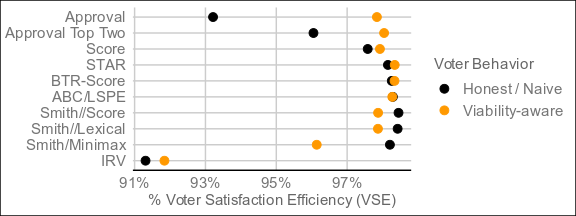
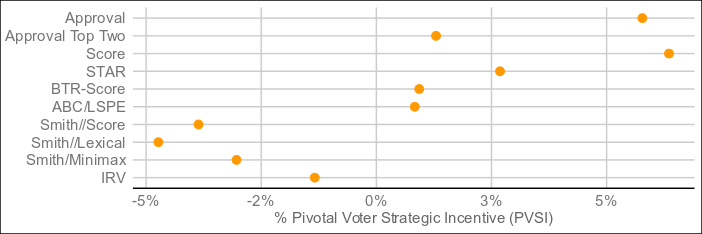

And the result of 10,000 simulated elections with 5,001 voters each:
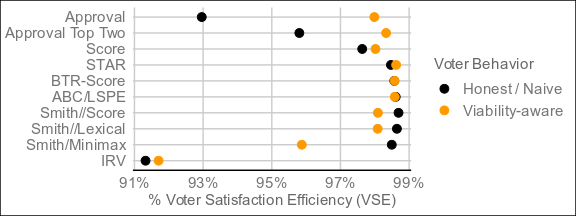
@Lime has pointed out that ABC is similar to Forest Simmons's Approval Sorted Margins, though given the latter's monotonicity and more complex heuristic it's doubtful that they're identical. Interestingly, Simmons is credited as the discoverer of sequential pairwise elimination methods.
I believe ABC may also pass the chicken dilemma as Approval Sorted Margins does, according to my understanding of the criterion.
If I understand correctly, in a situation in which candidates X & Y are similar and X+Y>50%>Z>X>Y, Y voters should not be able to force a win for Y by refusing to vote X over any other candidate while X voters honestly vote Y over Z. The problem is that if you don't know whether your candidate is X or Y, the strategic score vote is to score the other candidate zero.
However, if it were possible to score the other candidate zero while still ranking them above Z, there's no incentive for either faction not to do at least that.
Under ABC, the strategic choice for both factions is to rate the other candidate at worst E, provided that they both rate Z last, as doing so will not risk raising their opponent's score above their own candidate's while still ensuring that their combined preferences beat Z.
If Y voters defect by not rating X above Z, they cannot force a win for Y, as X would beat Y pairwise and then go on to lose against Z. If Y happened to be more preferred than X, the same would go for X voters. If neither faction defects then either candidate defeats Z. Thus this method passes the chicken dilemma as far as I can tell, but I welcome any corrections. (I may be overlooking any potential for turkey-raising, for one.)
Where ABC may have a slight edge over BTR-Score is the fact that ABC removes the incentive to not rate disapproved candidates over even more disapproved candidates (because rating any candidate necessarily means partial support in score), which may be why ABC appears to be more resistant to Burial. I believe this method is worthy of serious consideration.
Both BTR-Score and ABC are probably the best found yet in terms of accuracy and strategyproofness as related to simplicity, and the results above seem to bear that out. I'd definitely appreciate any independent testing in vse-sim or other simulations with different voter models so I know it's not just a quirk of how I wrote the method (though even that may be useful insight).
-
@ex-dente-leonem could this be generalized with a ranking plus approval cutoff with the same runoff mechanism? I also feel like there may be burial issues, am I wrong?
-
@cfrank I only generalized it for converting score to nonlinear score plus approval cutoff, but maybe you'll find it helpful:
(1/(1+((s/n)^(log(2)/log(t))-1)^α)
where s = score, n = top rank, t = threshold between 0 and 1, and α = steepness.
From here.
With high enough α the threshold approaches verticality and the function approximates approval. There's probably a much simpler way to do it with rounding or floor/ceiling, but the issue is how to retain preferences.
(Very preliminary testing shows that for some reason the function may be optimized for VSE around α = e, which seems in line with my (purely speculative philosophically biased lol) intuition that the best voter utility may be nonlinear and perhaps looks more like logarithmic score voting.)
As for burial, seems to be the opposite; it consistently shows the best resistance out of the methods I've tested, which to be fair have only been the above. Any burial resistance seems more due to the method itself and not necessarily the pairwise elimination, since BTR-Score is less resistant (but still performs very well).
-
@ex-dente-leonem what I mean is that a voter could submit a ranking of candidates and then choose above which ranking they want to give approval points. Then there’s no need to use any fixed set of ordinal scores like A,B,C,etc. That gives voters more flexibility to indicate their preferences.
In any case I think it makes sense, and I like the way the method works. It seems to address a lot of issues at once.
The system I consider which is more or less the same but with a minor adjustment is for voters to submit (partial) rankings of candidates (with equality) and a rank for approval cutoff. Then the winner would be decided in accordance with the result of the following algorithm:
- Let N be the number of candidates.
- From the N candidates with the lowest approval ratings, determine if a Condorcet loser exists.
- If no Condorcet loser exists, reduce N by 1 and repeat from step 2.
- If a Condorcet loser exists, eliminate them from the election, let N be the number of remaining candidates, and repeat from step 2 until a single candidate remains.
There may be a more efficient algorithm that results in the same winner. It’s basically “bottom N runoff” where N starts large and decreases conservatively to partially mitigate the possible dependence of the end result on the order of elimination.
What else is nice is that if there are tied weak Condorcet losers, they can all be eliminated at once, and the algorithm will halt when there is a Condorcet cycle of equally approved candidates, which will almost always be just one candidate.
-
@cfrank Like a total preference order + sequential elimination? That's a really great idea, I'll try to come up with something.
-
@ex-dente-leonem in principle some kind of heuristics could be used to speed up that algorithm^ I wonder if it can be written in O(N logN) expected time. I would also be interested to know if this method is actually the same as Condorcet//Approval.
And if that’s true, it seems like a generalization would be (Absolute) Smith//Score as suggested by @Lime and @Jack-Waugh (and perhaps many others).
Otherwise if they’re different, it would also be interesting to see how they differ.
-
@cfrank I couldn't come up with a way to write/convert a method for this in vse-sim, but I wanted to try out your bottom-N runoff suggestion for the BTR methods.
I literally said "Holy shit" when I did my first run of 200 just now and saw this.
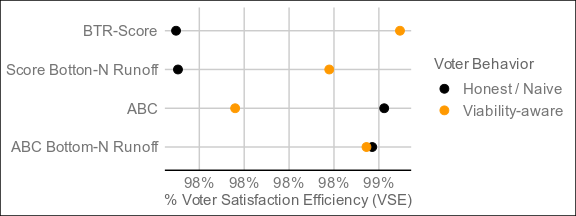
I eliminated weak Condorcet losers instead since that seemed to cause less problems with ties, and eliminated the lowest scorer at N = 1 so the algorithm wouldn't halt, but let me know if that's okay or not. I'm about to do a run of 4000 with the current settings and will post the results when complete.
-
@cfrank Here are the results of 4,000 runs under the same conditions as the original, with STAR included for comparison:
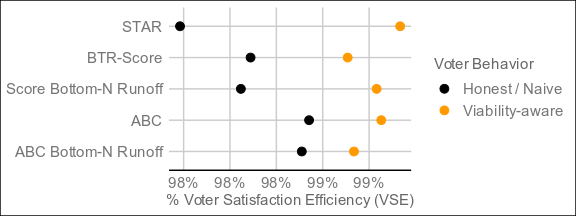
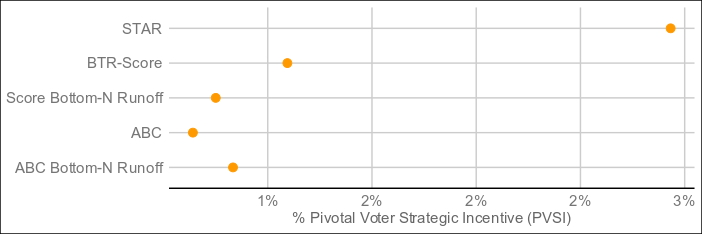

Continued great performance, but may not be worth the increase in complexity.
Below is the code for Bottom-Two and Bottom-N Runoff respectively, with any suggestions for improvement greatly welcome:
@classmethod def results(cls, ballots, **kwargs): baseResults = super(BTR0to, cls).results(ballots, **kwargs) candidateIndices = list(range(len(baseResults))) remainingCandidates = candidateIndices[:] while len(remainingCandidates) > 1: (secondLowest, lowest) = sorted(remainingCandidates, key=lambda i: baseResults[i])[:2] upset = sum(sign(ballot[lowest] - ballot[secondLowest]) for ballot in ballots) if upset > 0: remainingCandidates.remove(secondLowest) else: remainingCandidates.remove(lowest) winner = remainingCandidates[0] top = sorted(range(len(baseResults)), key=lambda i: baseResults[i])[-1] if winner != top: baseResults[winner] = baseResults[top] + 0.01 return baseResults@classmethod def results(cls, ballots, **kwargs): baseResults = super(BNR0to, cls).results(ballots, **kwargs) candidateIndices = list(range(len(baseResults))) remainingCandidates = candidateIndices[:] def pairwiseLossOrTie(candidate, opponent): return sum(sign(ballot[candidate] - ballot[opponent]) for ballot in ballots) <= 0 def findCondorcetLoser(remainingCandidates): for candidate in remainingCandidates: if all(pairwiseLossOrTie(candidate, opponent) for opponent in remainingCandidates if opponent != candidate): return candidate n = 1 while len(remainingCandidates) > n: for candidate in remainingCandidates: top_n_opponents = sorted(remainingCandidates, key=lambda i: baseResults[i], reverse=True)[:n] if all(pairwiseLossOrTie(candidate, opponent) for opponent in remainingCandidates if opponent not in top_n_opponents): return candidate n += 1 return None while len(remainingCandidates) > 1: CondorcetLoser = findCondorcetLoser(remainingCandidates) if CondorcetLoser is not None: remainingCandidates.remove(CondorcetLoser) winner = remainingCandidates[0] top = sorted(range(len(baseResults)), key=lambda i: baseResults[i])[-1] if winner != top: baseResults[winner] = baseResults[top] + 0.01 return baseResults -
@ex-dente-leonem Is Viability-aware just strategic voting? Also how do all the methods do under one-sided strategy? So strategic voting versus honest voting.
-
@toby-pereira said:
@ex-dente-leonem Is Viability-aware just strategic voting?
More or less; each simulated election is preceded by an approval poll which factors into viability-aware strategies.
Also how do all the methods do under one-sided strategy? So strategic voting versus honest voting.
The original vse-sim had one-sided strategy analysis, but the newest version appears to have dropped that in favor of Pivotal Voter Strategic Incentive, which seems to measure how much coordination by one faction it takes to change the outcome. The lower the coordination needed, the greater the PVSI, while near-zero means little strategic effect and negative PVSI indicates greater risk of the strategy backfiring.
-
@ex-dente-leonem can you describe the conditions? For example, what is the generic PVSI without a specified strategy? Is it a mean over a bunch of simulations with agents using random strategies?
Also I would like to learn more about agent based modeling and reinforcement learning in this context, I think it could give really interesting results. Finally, how many candidates were there and how were they generated? Probably I’ll have to read the paper.
-
@cfrank said:
@ex-dente-leonem can you describe the conditions? For example, what is the generic PVSI without a specified strategy? Is it a mean over a bunch of simulations with agents using random strategies?
As best as I can tell, the generic PVSI examines (from the point of view of the pivotal voter in a faction which changes the outcome) viability-aware strategies for specific voting methods, which in the case of STAR means:
Balance strategic exaggeration (using 5's and 0's instead of 3's and 2's to maximize influence in the scoring round) with the competing incentive of not wanting to give multiple viable candidates the same score. (This yields more 5's and 0's than the naive strategy and is mostly unaffected by the presence of non-viable candidates in the race.)
while the detailed one looks at the effectiveness of targeted strategies by whichever faction would benefit most from those strategies.
I used the same va-ballots and strategies as STAR for BTR/BNR-Score and ABC, partially because of the similar conflict between maximizing support for preferred candidates while taking later rounds into consideration, but mostly to make as few assumptions and to keep conditions as identical as possible.
Also I would like to learn more about agent based modeling and reinforcement learning in this context, I think it could give really interesting results. Finally, how many candidates were there and how were they generated? Probably I’ll have to read the paper.
Each of the 4000 simulated elections is run with 6 candidates and 101 voters (the difference between 101 and 5001 being minimal) on a hierarchical Dirichlet clustered spatial voter model. I'll run some 3-, 9-, and 12-candidate tests later, and I'm very interested in whether the same performance holds up in other simulations and models.
-
@ex-dente-leonem 3x better than what we got so that’s great! Typically how many dimensions are used for candidate platforms in these kinds of simulations?
-
@ex-dente-leonem said in ABC voting and BTR-Score are the single best methods by VSE I've ever seen.:
@toby-pereira said:
@ex-dente-leonem Is Viability-aware just strategic voting?
More or less; each simulated election is preceded by an approval poll which factors into viability-aware strategies.
Also how do all the methods do under one-sided strategy? So strategic voting versus honest voting.
The original vse-sim had one-sided strategy analysis, but the newest version appears to have dropped that in favor of Pivotal Voter Strategic Incentive, which seems to measure how much coordination by one faction it takes to change the outcome. The lower the coordination needed, the greater the PVSI, while near-zero means little strategic effect and negative PVSI indicates greater risk of the strategy backfiring.
I see. While also a useful metric, it is different enough for it to be worth having both. As it is we just see the VSE scores and separately this co-ordination measure. But it would be nice to know how much it could drop the VSE by.
-
Ex dente leonem gave these instructions for ABE voting:
Rate each candidate from A to F, A being best and F being worst.
Candidates receive 1 point for each A, B, or C rating and 0 points for each D, E, or F rating.
Equal ratings are allowed. Unrated candidates are automatically rated F.
An explanation for voters:
*The points seed a tournament. The first game matches the candidates with the two lowest point totals.
In each game, the A, B, C, D, E, F ratings determine which candidate is preferred by each voter. If you gave candidate Mike a D, and candidate Tim a B, your vote would go to Tim.
The winner would face the candidate with the next lowest number of points. This is repeated until the survivor meets the candidate with the highest number of points in the final game to determine the winner.
A spoiler effect is nearly impossible with ABC voting.*
ABC is one notch more complex than BTR-Score, which is quite simple as Condorcet methods go.
Is “nearly impossible” a fair statement?
What other benefits should we highlight for the public?
Were you using Jonathan Quinn’s VSE?
Thanks for the great thread.
-
I have to admit that I'm confused by the results. I did expect BTR-score to perform well, but I also thought that the difference to Smith//score would be to small to measure. I wonder why there is such a big difference.
Also, when looking at viability-aware, STAR performs a lot better, which is also surprising. Is it that it better utilizes the score part and therefor gets the "best of both worlds"? I don't know.
How long does it take for you to run those simulations?
If it's not too much work, could you try out MARS? It's basically like BTR-score, but each round does not only compare votes, but votes+scores (both measured in % of maximum possible). Previously I thought that that would be even better than BTR-score (on the cost of being complicated), but now I'm no longer sure.
One thing to be cautious of is that these results present very small differences in a high range. It might be that the choice of model has too much of an influence to make decisive claims.
ABC is a good idea and I think could be really a viable method when fleshed out. Most importantly I think there may be more intuitive ways to preset it. Maybe something in between scores and approval, like "ABC-123" where letter ratings count as 0 and numbers as scores.
-
@cfrank Apologies for the late response; most of the voter model is a black box to me but this from the earlier version (in reference to a less complex model):
Voters and candidates each have a location in n-dimensional “ideology space”. A voter’s satisfaction for a given candidate goes down linearly with the ideological distance between the two. Locations are normally distributed, using the same distribution for candidates and voters; and the standard deviations for each dimension follow an exponentially descending sequence such as 1, 1/2, 1/4, 1/8, etc. The number of dimensions is set so as to be large enough that further dimensions would be insignificant. Thus, the only important parameter is the rate of exponential decay; in the example sequence above, it’s 2.
implies it's quite a large number.
-
@toby-pereira I'd like to see that as well. I'll take some time to check out the original CES vse-sim and compare results on both.
-
@gregw said:
A spoiler effect is nearly impossible with ABC voting.*
Is “nearly impossible” a fair statement?
That seems fair, as it requires a cycle of at least four candidates in a specific configuration.
What other benefits should we highlight for the public?
Voters disinclined to vote for the lesser of two evils but also seeking to mitigate their worst outcome can safely do so without actually supporting the less disfavored of two unpopular frontrunners, as expressing preference in ABC doesn't necessitate support, and their full votes can go to more preferred alternatives. I also like that the mechanic is evocative of letter grading and allows voters to rate candidates in a sense similar to what we're already familiar with.
Were you using Jonathan Quinn’s VSE?
Yes, it can be found here.
Thanks for the great thread.
Much appreciated, thank you.
-
@casimir said:
I have to admit that I'm confused by the results. I did expect BTR-score to perform well, but I also thought that the difference to Smith//score would be to small to measure. I wonder why there is such a big difference.
I was wondering the same actually, and I think it may have something to do with how strategic voting is evaluated with Smith methods in vse-sim, specifically existing base methods run on Smith sets. For one thing the only targeted strategy available for analysis by default is bullet voting. I suggest disregarding PVSI and va behavior for Smith//Score and just looking at honest voters, which seem in line with expectations.
Also, when looking at viability-aware, STAR performs a lot better, which is also surprising. Is it that it better utilizes the score part and therefor gets the "best of both worlds"? I don't know.
My speculation is that STAR's single runoff as compared to BTR-Score's several widens the window of advantage for strategy.
How long does it take for you to run those simulations?
It depends on how many moving parts there are, but to give a rough idea here's how many minutes it takes to run 200 elections with 101 voters and 6 candidates on the following methods:
STAR - 1:38
BTR-Score: 1:49
BNR-Score - 2:51
ABC - 1:58
MARS - 1:54 (This one was a pleasant surprise)But should be a lot faster on newer machines.
One thing to be cautious of is that these results present very small differences in a high range. It might be that the choice of model has too much of an influence to make decisive claims.
Very true, but given that these replicate as closely as possible the conditions of the STAR paper (which is cited as part of official advocacy efforts), I believe they're definitely worthy of attention. That said, these are all excellent methods VSE-wise, and I think most importantly underline how powerful sequential pairwise elimination is as part of any hybrid method,.
If it's not too much work, could you try out MARS? It's basically like BTR-score, but each round does not only compare votes, but votes+scores (both measured in % of maximum possible). Previously I thought that that would be even better than BTR-score (on the cost of being complicated), but now I'm no longer sure.
 Have I got great news for you... The title of this thread is officially obsolete.
Have I got great news for you... The title of this thread is officially obsolete.Here are the result of 4,000 elections:
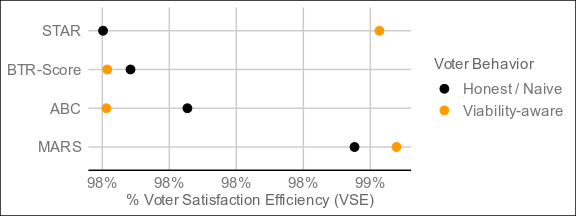
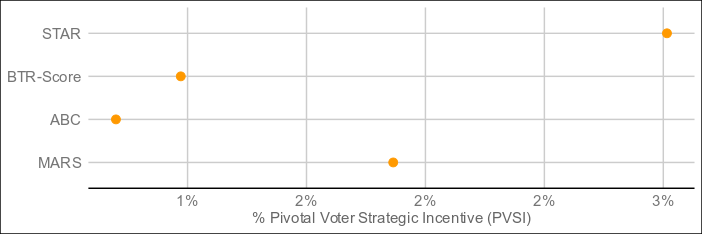

The undisputed best performer by VSE of the four is MARS, which threads the needle between Condorcet and utility methods by being neither and both, and blazing ahead as a result. The resolution mechanism is a step more complex than bottom-two runoff, but still less so than a full pairwise preference matrix (with potentially better results than such), and it resolves in around the same time as ABC and BTR-Score. For electorates who don't care too much about what's under the hood as long as it's transparent, this might be the one.